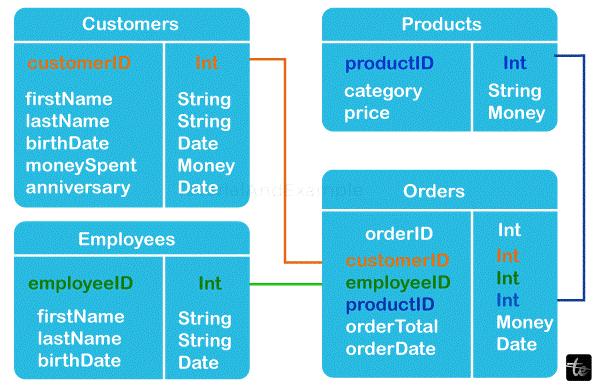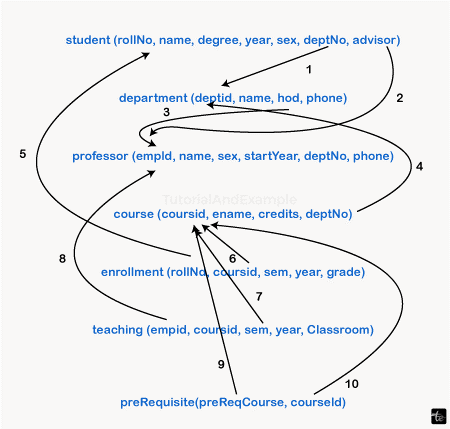Relational Schema
Introduction
A relational schema is a diagram that illustrates how businesses store and arrange data in databases. The connections that make up the database are also displayed. Developers frequently see relational schemas as the form, structure, or style of the data sets stored in a database. Relational schemas are only blueprints and do not hold actual data. The objective of a developer is to create a schema that minimizes repetition and guarantees understandable information. The developer can show a schema as formulas written in a programming language or as a visual representation, such as a graph.
Schemas come in two varieties: logical and physical
- Physical schema: This describes the representation and storage of data in a database management system (DBMS). It has to do with the data structure that was employed to create the database's schema. Example: Hashing, B-tree, etc. Physical schema resembles the human body's physical structure.
- Logical schema: This schema defines all logical constraints used to store data. A conceptual model of data is called a logical schema. This type of schema relates to the concepts and logic that the database uses to keep itself operating correctly. A logical schema is analogous to the human body's internal mechanisms.
What does a Relational Database Schema include?
Many components combine in relational database schemas to create a simple and easy-to-use database. Every element of a relational database schema contributes to defining the relationships inside the database.
The following features should be present in a relational database schema:
Tables
Tables, essentially collections of records, are the primary building blocks of relational schemas. Tables typically have a name and a data type, and they are categorized by subject. Tables in a relational database design are used to arrange data sets that programmers may use to create databases. The size of the project determines how many tables are needed.
Attributes
Features are the things that are in every table. Every table has characteristics that specify or characterize the topic of the table. For instance, a relational schema for a bakery may have tables with features for ingredients, baked product varieties, pricing, and customer information. A table's entries are determined by attributes, defining qualities in a relational database structure. These may aid in elaborating on and strengthening connections between table relationships.
Relations
The developer must add ties, or connections, to the relational schema after it has the appropriate number of tables. Developers frequently use lines or arrows to symbolize connections. Relations are used to display on the schema the relationships between each table. Several possible interpretations exist for the lines or arrows, including two qualities being in the same field.
Primary Keys
A column or set of columns that identify table fields are primary keys. A primary key is a unique identification for every row in a table. Since a table cannot have duplicate rows, the primary keys for each column are special. The value cannot be null since it must exist within the primary key. It's also crucial to remember that each table can only have one primary key implemented by the developer.
Foreign Keys
Relational database schemas frequently use foreign keys as well. A column, or set of columns, indicates connections between tables and is called a foreign key. Foreign keys are often primary keys from other tables to facilitate finding relations between tables. As a result, the foreign key refers to the primary key of a prior table. In contrast to primary keys, foreign keys may include duplicate rows, and their values may be null yet still function. Furthermore, a table may consist of many foreign keys.
Benefits of Relational Database Schemas

Relational database schemas are the best tools for storing, arranging, and creating tables for database data. Starting with a schema might benefit businesses or websites that use relational databases.
A relational database schema has the following advantages:
Organization
Since databases frequently include a large amount of information, employing a database schema may greatly aid in keeping each piece of data organized. Information may also be arranged using the relations by relating several fields to one another. An excellent way to build a relational database is to collect data according to the relationships between various tables or characteristics.
Accuracy
Information in a database may be kept accurate and consistent thanks to database schemas. Correct fields and relationships can contribute to creating a valuable and exciting database for businesses or websites that need to organize and analyze a lot of data. When building the relational database, relations inside schemas also aid in accurately managing rows and columns.
Accessibility
The tables and information sets are available via the explicit, easy-to-read relational database schemas. Database schemas are primarily used to make information accessible. By specifying tables, characteristics, and connections, programmers may easily navigate the information and use the relational schema as the database's guide. Accessibility testing may be used to generate accessible data and tools.
For Example:
As an illustration, a relation schema specifies the layout and composition of a relation, including the relation name and a list of characteristics, field names, and column names. Each part would have a domain that goes along with it.
A student called Geeks is enrolled in the fourth year of her B. Tech program. She is a member of the IT department (department no. 1) and her roll number is 1601347. It is Mrs. S Mohanty who is proctoring her. A student table with the following properties would need to be created to represent this using a database: name, sex, degree, year, department, department number, roll number, and proctor (adviser).
student (name, degree, year, sex, department, advisor, and roll number)
Note: Other students' information can be recorded if a database is created.
In the same way, the IT Department is headed by Mrs. Sujata Chakravarty and has department ID 1. Additionally, we can give the department a call at 0657 228662.
The department table, which has the characteristics of department ID, name, phone, and head office, may represent this department and others.
Department (name, phone, HoD, and DeptId)
A student's chosen course has a department number, course name, credit, and course ID.
Course (course, name, credits, deptNo) the professor's name, sex, department number, and phone number would be listed as their employee IDs.
Professor (empId, name, sex, startYear, deptNo, phone). We may also create an enrollment table with the following attributes: roll no., course, semester, year, and grade.
enrollment (year, grade, semester, rollNo, course)
Having an employee ID, course ID, semester, year, and classroom as characteristics, teaching may be represented by another table.
Teaching (classroom, semester, year, courseid)
The Prerequisite table, which has prerequisite course and course ID properties, may be used to illustrate how some systems require completion of another course before moving on to the current one.
prerequisite (course, preReqCourse)

The following Relation diagram shows the relationships between them as arrows.
This indicates that the department ID used in the department table and the dept in the student table are the same.
1. A foreign key in the student table is deptNo. In the department table, it alludes to deptId.
2. This indicates that the adviser is a foreign key in the student table. It alludes to the professor table's empId.
3. This illustrates that the department table's head is a foreign key. It alludes to the professor table's empId.
4. This shows that the department ID used in the department table and the dept in the course table are the same. A foreign key in the student table is deptNo. In the department table, it alludes to deptId.
5. This shows that the rollNo used in the student and enrollment tables are the same.
6. This shows that the courses in the course and enrollment tables are the same.
7. This shows that the course in the course table and the teaching table are the same.
8. This indicates that the professor table's empId and the teaching table's empId are the same.
9. This indicates that the prerequisite table's preReqCourse is a foreign key. In the course table, it alludes to the course.
10. This shows that the department used in the department table and the dept in the student table are the same.